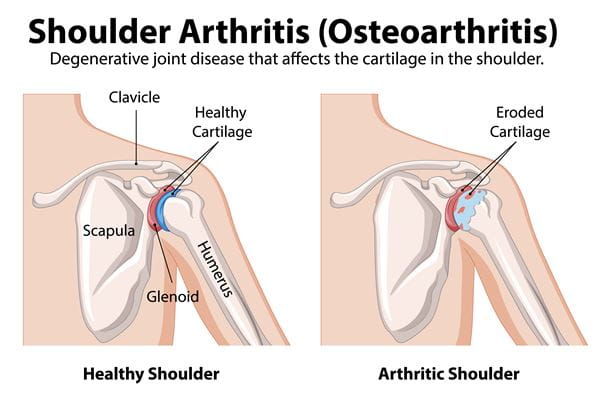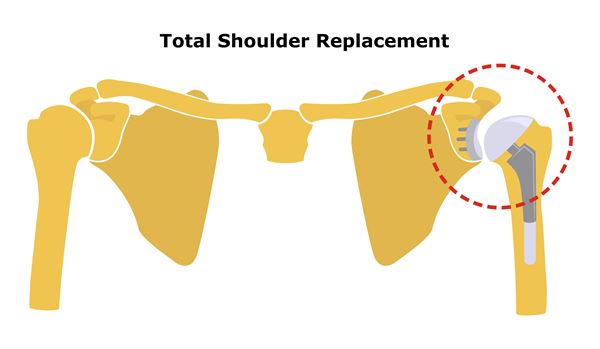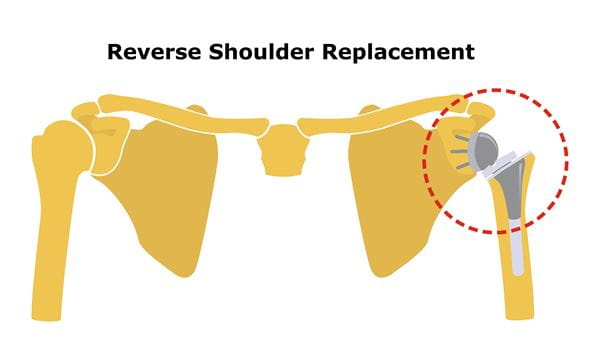Our shoulders are among the most complex and flexible joints in the human body, allowing for a wide range of motion. But when simple movements like brushing your hair or pulling on a shirt become painful, it may be a sign of shoulder osteoarthritis, a progressive joint condition that affects millions.
What Is Osteoarthritis?

Osteoarthritis, often called “arthritis osteo” or degenerative joint disease, is the most common form of arthritis. It frequently develops in weight-bearing joints like the hips and knees, but can also affect the shoulder, especially in people over 50.
In a healthy shoulder, cartilage provides a smooth cushion between bones, allowing for frictionless movement. Over time, this cartilage can wear away due to age, repetitive use or prior injury. As it erodes, bones begin to grind against each other, leading to:
- Persistent shoulder joint pain
- Swelling and tenderness
- Stiffness and reduced range of motion
- A warm sensation in the shoulder
- Clicking or grinding sounds (crepitus)
As the joint attempts to repair itself, it may develop bone spurs, which further inflame the area and aggravate nearby tendons, sometimes leading to rotator cuff damage.
“Our shoulders can ache due to an injury, of course, but also because of wear and tear over the years,” says Paul B. McLendon, M.D., a Riverside orthopedic surgeon specializing in shoulder and elbow treatments. “That’s when it’s challenging for patients to know when to come in and seek help.”
If shoulder discomfort lasts longer than a week or recurs frequently over several months, it’s time to consult a specialist.
Nonsurgical Relief for Shoulder Joint Pain
Early treatment for shoulder arthritis focuses on noninvasive approaches to minimize inflammation and restore function.
“Our first goal will be to treat your condition without surgery,” Dr. McLendon explains. “We have a lot of options to try before we start to discuss surgery.”
These may include:
- NSAIDs like ibuprofen or naproxen to reduce inflammation
- Corticosteroid injections to manage flare-ups
- Heat or ice therapy to ease stiffness or swelling
- Physical therapy to strengthen muscles and improve shoulder mobility
- Activity modification, including avoiding heavy lifting or overhead motion
These strategies are often effective for managing mild to moderate cases of shoulder osteoarthritis.
When Is Shoulder Surgery Needed?
If conservative treatments no longer control your symptoms or if the arthritis has significantly damaged the joint, surgical intervention may be recommended. Your orthopedic surgeon will tailor the approach based on your level of damage, activity goals and rotator cuff condition.
Types of Shoulder Surgery:
Anatomic Total Shoulder Replacement:

The damaged ball of the upper arm bone, or the humerus, and the socket of the shoulder blade are replaced with prosthetics. This procedure mimics the natural anatomy and is ideal when the rotator cuff is intact.
In this type of shoulder replacement surgery, the surgeon replaces the damaged humeral head, which is the ball of the upper arm bone, with a metal ball and the glenoid, or shoulder socket, with a plastic socket. This configuration mirrors the natural structure of the shoulder joint.
Best Candidates:
- Patients with intact rotator cuff tendons
- Individuals with primary osteoarthritis
- Those with good bone quality and stable shoulder anatomy
Advantages:
- Preserves natural shoulder mechanics
- Offers excellent pain relief and functional improvement for the right candidates
Recovery Time:
- Most patients recover within 3 to 6 months
- Physical therapy starts early to restore range of motion and strength
- Full activity may resume by 6 months, depending on progress
Reverse Shoulder Replacement:

This technique switches the ball and socket placement. It is best suited for patients with severe arthritis and a torn or non-functioning rotator cuff.
In this procedure, the normal ball-and-socket structure is reversed: a metal ball is attached to the shoulder blade, and a socket is placed on the top of the humerus. This design shifts the center of rotation and allows the deltoid muscle to compensate for a deficient rotator cuff.
Best Candidates:
- Patients with severe rotator cuff tears (rotator cuff arthropathy)
- Individuals with previous failed shoulder surgeries
- Those with complex fractures or joint degeneration
Advantages:
- Provides improved stability and function when the rotator cuff cannot support the joint
- Reduces pain and allows for improved overhead arm movement
Recovery Time:
- Initial healing takes about 6 weeks
- Physical therapy typically begins after 2–4 weeks
- Full recovery may take 4 to 6 months, with continued strength improvements up to a year
“Shoulder replacement surgery is the only way to truly eliminate arthritis,” adds Dr. McLendon. “We walk our patients through the options to find what will give them the best quality of life.”
Living with Shoulder Osteoarthritis
While osteoarthritis in the shoulder can limit daily activities, early diagnosis and a proactive treatment plan can dramatically improve outcomes. Whether through conservative therapy or surgery, you don’t have to live with chronic shoulder pain.
Looking for relief from shoulder arthritis pain? Schedule an evaluation with one of our orthopedic specialists today to explore your treatment options. Early treatment can reduce the risk of chronic pain, arthritis and long-term joint damage.
At Riverside Orthopedic and Sports Medicine Specialists, we offer expert care and the latest techniques in surgical and non-surgical treatments. Find a convenient location near you and get back to doing what you love – without pain or limitation.
Schedule an appointment online so you can be evaluated right away.
Riverside OrthoConnect has next business day appointment availability in most cases.
Or call the Riverside Sports Medicine Hotline at 757-534-6767, from 7am-10pm, 7 days a week to schedule an appointment with a sports medicine specialist. Same day/next day availability in most cases.



